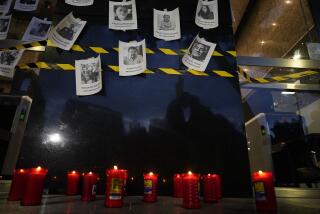From a Mexican kingpin to an FBI informant
WASHINGTON — Police and federal agents pulled the car over in a suburb north of Denver. An FBI agent showed his badge. The driver appeared not startled at all. “My friend,” he said, “I have been waiting for you.”
And with that, Jesus Audel Miramontes-Varela stepped out of his white 2002 BMW X5 and into the arms of the Federal Bureau of Investigation.
Over the next several days at his ranch in Colorado and an FBI safe house in Albuquerque, the Mexican cartel chieftain — who had reputedly fed one of his victims to lions in Mexico — was transformed into one of the FBI’s top informants on the Southwest border.
Around a dining room table in August 2010, an FBI camera whirring above, the 34-year-old Miramontes-Varela confessed his leadership in the Juarez cartel, according to 75 pages of confidential FBI interview reports obtained by The Times/Tribune Washington Bureau.
He told about marijuana and cocaine routes to California, New York and the Great Lakes. He described the shooting deaths of 30 people at a horse track in Mexico, and a hidden mass grave with 20 bodies, including two U.S. residents.
He told them about his African lions, which he had acquired as circus cubs. The story about feeding one of his enemies to them was false, he claimed, but he said he had seen plenty of “violence and suffering.” He told agents he was desperate to trade his knowledge for government protection. He wanted a new life for himself and his wife and three daughters.
A week later Miramontes-Varela pleaded guilty in federal court in New Mexico to a minor felony as an illegal immigrant in possession of a firearm. Then he disappeared, almost certainly into the federal witness protection program.
FBI officials in Arizona and Washington declined to comment about Miramontes-Varela, citing bureau policy against discussing informants. But the documents tell plenty.
During the interview sessions, Miramontes-Varela “provided significant information about drug trafficking activity,” the documents said, leading to several successful unnamed law enforcement operations in the U.S. and Mexico.
***
After Miramontes-Varela was stopped in Brighton, Colo., agents took him back to his ranch. They advised him and his wife, Mari, that he was “the subject of an FBI investigation for his involvement in drug trafficking, firearms trafficking, money laundering and the interstate transportation of stolen property.”
In Spanish, they read him his Miranda rights. He called an attorney; they spoke quietly in Spanish. Miramontes-Varela hung up and turned to the agents. “Yes,” he said. “He told me to do as much as I can for you.”
Miramontes-Varela signed the Miranda waiver and looked up at the agents. He asked, “Where do you want to start?”
First, they said, any guns?
Miramontes-Varela mentioned a black 9-millimeter semiautomatic Glock pistol he said he bought after being shot at in El Paso. The agents asked to see it. “Yes, yes, no problem,” he said. He walked to a floor safe in a far corner of the living room, unlocked it and handed the weapon over.
Agents drove the couple to the FBI safe house in Albuquerque. Inside, they pointed to two cameras. One was in the master bedroom, where Miramontes-Varela and his wife would stay. Agents showed that that it was unplugged and that they had covered it with a white plastic bag. “Very nice,” Miramontes-Varela said.
Miramontes-Varela talked to them around the dining room table. That is where the other camera was. It stayed on.
***
His story poured out. He was born the third of 10 children in Terrero, Mexico, and grew up in Namiquipa, northern Mexico. He married when he was 18, his bride 15. They sneaked though Nogales, Ariz., coming to the U.S., he said, “to make money.”
They settled in Denver. Miramontes-Varela installed drywall. But in the late 1990s a brother, Yovany, lost an arm in a tractor mishap, and Miramontes-Varela returned home. He grew apples and traded in cattle.
In early 2002, he said, the Juarez cartel came to Namiquipa. Pedro Sanchez, known as El Tigre, controlled things. He offered Miramontes-Varela a job collecting a monthly $35,000 “tax” from marijuana growers.
Every 15 days, growers carted 20 tons to a local warehouse. It was shipped north through El Paso, the proceeds funneled back to the cartel and the growers.
One day the military arrived and gunfire ensued. “The mayor and town treasurer were killed,” Miramontes-Varela said. Later, El Tigre was arrested.
In 2008, Miramontes-Varela said, he fled with his family to El Paso. When he failed to return, the cartel burned his ranch and stole his cattle, all 120 cows. He was done with the violence, he said.
***
That part, according to the FBI, was not true. Miramontes-Varela shuffled between ranches in New Mexico and Colorado, they said, often in an armored car with bodyguards, and set up his own drug- and gun-smuggling operation.
When a courier was arrested with 18 kilos of cocaine, Miramontes-Varela offered the man’s family the choice of one of his 16 homes in Mexico, including his “big house,” according to telephone wiretaps outlined in the documents.
In March 2010, the FBI listed him as head of the “Miramontes-Varela Drug Trafficking Organization,” tied to the Juarez, Sinaloa and Los Zetas cartels. From two confidential sources and two wiretaps, agents learned that his organization had stolen tractors in the U.S. and driven them to Mexico as payment for lost loads. One debt alone reached $670,000. They learned that one of Miramontes-Varela’s bosses in Mexico, “Temoc,” was tortured and killed by the Sinaloans.
The Bureau of Alcohol, Tobacco, Firearms and Explosives also wanted him arrested. It had tracked $250,000 in illegal gun purchases to Miramontes-Varela and his brother through its ill-fated Fast and Furious gun-smuggling surveillance operation in Arizona.
FBI agents rigged a 24-hour pole camera outside his ranch near Santa Teresa, N.M. But Miramontes-Varela figured it out. Five of his men in two vehicles followed a surveillance agent for 90 minutes, then slashed his tire.
More ominously, the FBI learned Miramontes-Varela and his organization had bribed U.S. officials in El Paso and New Mexico. They decided it was time to bring him in.
On Aug. 18, 2010, they followed him from his Colorado farm. He briefly visited a Walgreens, then the State Patrol pulled him over. The time was 11:20 a.m. They had him.
***
In the safe house dining room, agents brought out maps, and Miramontes-Varela sketched in smuggling routes. He said weapons were easily acquired in this country, including .50-caliber rifles. “Good for long-range sniper fire,” he said.
He filled in the cartel hierarchies too. One chieftain had arm and shoulder scars from bullet wounds. At the horse track murders, the chieftain wore a mask. Some switched sides; others died when loads went missing.
And he told them about that mass grave in Palomas, Mexico. Authorities dug up 20 decaying corpses. Miramontes-Varela, the FBI’s new informant, was right.
More to Read
Start your day right
Sign up for Essential California for news, features and recommendations from the L.A. Times and beyond in your inbox six days a week.
You may occasionally receive promotional content from the Los Angeles Times.







